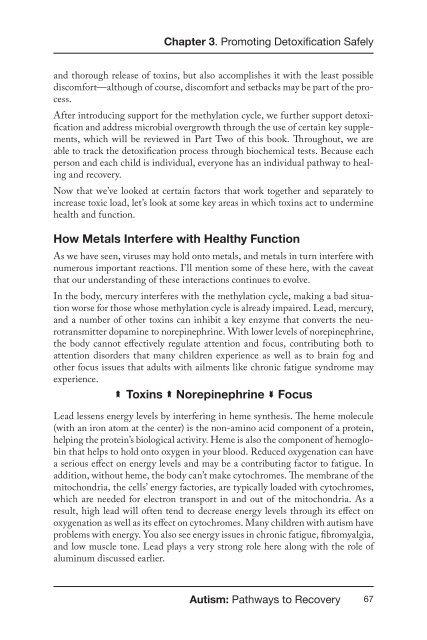3dT4E4Rnm
3dT4E4Rnm
3dT4E4Rnm
Create successful ePaper yourself
Turn your PDF publications into a flip-book with our unique Google optimized e-Paper software.
Chapter 3. Promoting Detoxification Safely<br />
and thorough release of toxins, but also accomplishes it with the least possible<br />
discomfort—although of course, discomfort and setbacks may be part of the process.<br />
After introducing support for the methylation cycle, we further support detoxification<br />
and address microbial overgrowth through the use of certain key supplements,<br />
which will be reviewed in Part Two of this book. Throughout, we are<br />
able to track the detoxification process through biochemical tests. Because each<br />
person and each child is individual, everyone has an individual pathway to healing<br />
and recovery.<br />
Now that we’ve looked at certain factors that work together and separately to<br />
increase toxic load, let’s look at some key areas in which toxins act to undermine<br />
health and function.<br />
How Metals Interfere with Healthy Function<br />
As we have seen, viruses may hold onto metals, and metals in turn interfere with<br />
numerous important reactions. I’ll mention some of these here, with the caveat<br />
that our understanding of these interactions continues to evolve.<br />
In the body, mercury interferes with the methylation cycle, making a bad situation<br />
worse for those whose methylation cycle is already impaired. Lead, mercury,<br />
and a number of other toxins can inhibit a key enzyme that converts the neurotransmitter<br />
dopamine to norepinephrine. With lower levels of norepinephrine,<br />
the body cannot effectively regulate attention and focus, contributing both to<br />
attention disorders that many children experience as well as to brain fog and<br />
other focus issues that adults with ailments like chronic fatigue syndrome may<br />
experience.<br />
Toxins Norepinephrine Focus<br />
Lead lessens energy levels by interfering in heme synthesis. The heme molecule<br />
(with an iron atom at the center) is the non-amino acid component of a protein,<br />
helping the protein’s biological activity. Heme is also the component of hemoglobin<br />
that helps to hold onto oxygen in your blood. Reduced oxygenation can have<br />
a serious effect on energy levels and may be a contributing factor to fatigue. In<br />
addition, without heme, the body can’t make cytochromes. The membrane of the<br />
mitochondria, the cells’ energy factories, are typically loaded with cytochromes,<br />
which are needed for electron transport in and out of the mitochondria. As a<br />
result, high lead will often tend to decrease energy levels through its effect on<br />
oxygenation as well as its effect on cytochromes. Many children with autism have<br />
problems with energy. You also see energy issues in chronic fatigue, fibromyalgia,<br />
and low muscle tone. Lead plays a very strong role here along with the role of<br />
aluminum discussed earlier.<br />
Autism: Pathways to Recovery<br />
67


